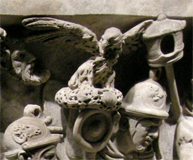
This page created 29 March 2014, and last modified: 26 September 2015 (some missing Maier reference numbers added)

In the western half of the empire, the senior-most unit of the legiones palatina is the Ioviani seniores, listed (98/9.21 in Ingo Maier's numbering scheme) under the Magister Peditum and assigned (102/5.54) to his Italian command. Its shield pattern (92#2), as shown in various manuscripts, is as below:

Note that the label (92.b) in the printed Froben edition is given as the Ioviani, but the manuscripts P, M, and W give Iovininani, while in the Bodleian manuscript (O) gives Iovininani sen..
This pattern shows an unusual amount of variation between the various manuscripts, not aided by my suspicion that the Froben manuscript has probably got its pattern swapped with that of the adjacent Herculiani seniores (98/9.22). It is one of a set of four very similar patterns, belonging to the Ioviani seniores, Herculiani seniores, Ioviani iuniores (9.18), and the Herculiani iuniores (9.19), with the two paired iuniores units being in the east, under the command of the first Master of the Soldiers in the Imperial Presence, and the two paired seniores units in the west, under the Magister Peditum (when the "original" Ioviani and Herculiani legions were split into seniores and iuniores units is unknown, other than being likely mid-4th century). The patterns shown below taken from the Paris manuscript clearly show this relationship:

While the eagle (aquila) is an attribute (i.e. symbol) of Jupiter (Iovius), and thus might reasonably appear on a shield bearing the name Ioviani, what is being shown here is probably not a bird, as such, but the image of a legionary standard in the form of an eagle, since the images of the two iuniores units show clear signs that they are standards (carrying a wreath in the case of the Ioviani iuniores, and being perched on a short cross-bar, in the case of the Herculiani iuniores).
Legionary eagle standards seemed to have taken a variety of forms. To the left is that of Legio III Cyrenaica, as depicted on a denarius of Marcus Antonius struck in 32 BC (picture from http://www.cngcoins.com under CCA 3.0 license). In the middle is that of Legio IIII Flavia from the Portonaccio Sarcophagus of ca. 190 AD (picture from National Museium of Rome under CCA 3.0 license). On the right is that of Legio I Minerva, from Trajan's column (picture by Peter Rockwell, and taken from www.stoa.org).



Unfortunately no legionary aquila has survived to the present day, although a non-legionary Roman eagle has been recovered from Silchester in Britain, minus its wings.
The "original" Ioviani legion was a Tetrarchic creation of the last quarter of the 3rd century; Ioviani refers not only to the god, but also the senior emperor, Diocletian (in much the same way Herculiani refers to not only Hercules, but the junior Augustus, Maximian). Interestingly, the Arch of Galerius (another of the Tetrarchs, who was identified with Mars), shows two shield patterns that apparently belong to the Ioviani and Herculiani units: one shows an image of Hercules (readily identifiable by his club and lion skin); the other, depicted below, shows an eagle.

This eagle is much smaller in proportion to the size of the shield than those born by the Ioviani units shown in the Notitia, being closer in scale to those borne in the Notitia by e.g. the Quartodecimani (18.17) under the Magister Militum per Thracias.
Possible inscriptional evidence for the Ioviani seniores comes from the cemetery at Colonia Iulia Concordia (modern Portogruaro in Veneto, Italy), which produced an inscription (ILS 551; photo here) mentioning a soldier EX N MILIT IOVIANORVM, which clearly means "ex numero militum Iovianorum"; see here for Hoffmann's 1963 analysis (in German). This however, might instead refer to the Ioviani iuniores, since this unit presumably spent time in the vicinity of Concordia in the years 394 and 395 in the struggle between Eugenius and Theodosius I. Other attestations without specifying seniores/iuniores are CIL 3.10232, from Sirmium, with N IOV, i.e "n(umero) Iov(ianorum)"; and ILS 2788, from Arles (photos here), with MILIT INT IOVIANOS, i.e "milit(avit) Int(er) Iovianos". More secure is that from a gravestone from Milan (CIL 5.6213 = ILS 2789; photo here) commemorating one Derdius, who retired as a tribune after serving 40 years in the IOVIANOS SEN. Another such epigraphic attestation is CIL 13.3687, from Trier (photo here), somewhat damaged, with IO[...]N[.]S SENIORIS, i.e "Io(via)n(o)s senior[e]s". See Tomlin, 1972 (available here), at p 273.
Exactly which "original" Ioviani legion became the Ioviani (seniores) is hard to discern: it seems that three pairs of Ioviani-Herculiani legions were formed under Diocletian and Maximian. Legio I Iovia and Legio II Herculia garrisoned Dux Scythiae, and detachments are still recorded (74.19-25) as being stationed there in the Notitia. Legio V Iovia and Legio VI Herculia garrisoned Pannonia II, and detachments are still recorded as being stationed there in the Notitia (141.24-28). Legio IV Iovia is unattested, but presumed from the existence in the Notitia of a Legio III Hercul(i)a (98/9.112), and which is listed (102/5.105) as being part of the field army of the Comes Illyricum. It may well be that the Ioviani seniores had its origins in a putative Legio IV Iovia stationed in north Illyricum as a reserve for the western Danube region rather than Legio I Iovia or Legio V Iovia. Note that Vegetius (1.17) says the Ioviani and Herculiani were renamed by Diocletian and Maximian rather raised by them - one should be alive to the possibility that any unit formed by the Romans might have been a more of a rebranding exercise involving one or more former units than enrolling a new body of men.

Return to the Notitia alphabetical unit list page.
Return to my Notitia index page.